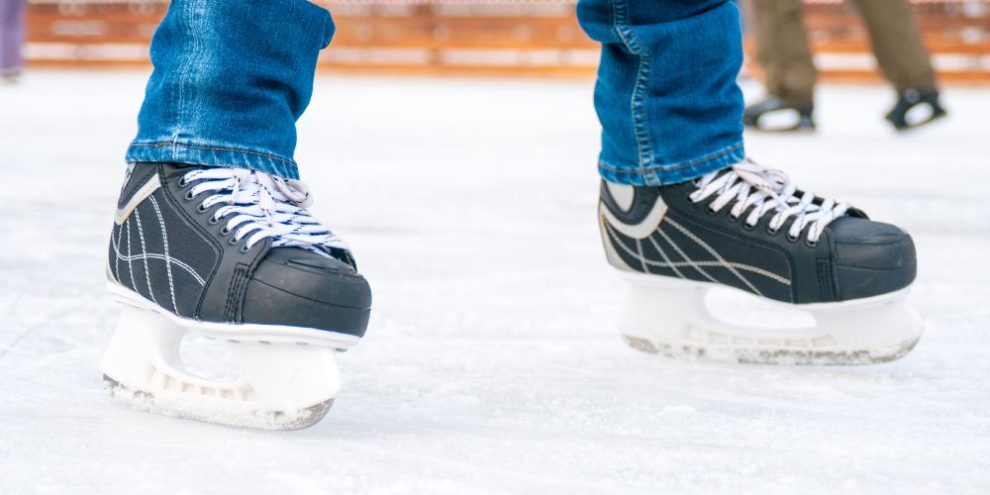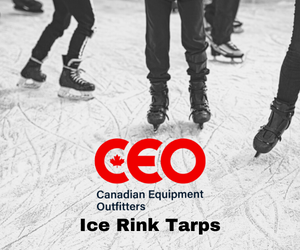
This Barrie 360 content is brought to you by Canadian Equipment Outfitters
If you’re a lover of hockey, figure skating or just gliding around the ice then a backyard rink is for you. Building your own rink is a great way to get the most skating time you can, without having to worry about sharing the ice, rowdy teens or poor surface maintenance.
When you build a backyard skating rink, you’re essentially creating a shallow above ground pool. While there are many different ways to create your rink, each has three common components:
- Boards – to shape the rink
- Bracing – to keep everything in place
- Liner – to hold water until it freezes (and protect your lawn)
To make your job as easy as possible, you want to be sure you frame your rink before the ground freezes. This will make it easier to install your bracing in Step 4.
But let’s not get too far ahead of ourselves. Before you do anything else, you have to figure out whether you can build a rink in your backyard.
1. Find Somewhere To Put The Rink
Many people skip this step because they believe their yard is level. The problem is, yards can be deceiving and even the slightest elevation can create a big mess.
To find the perfect place for your skating rink, look for the largest most level piece of property you can. The amount of land needed will depend on the size of your rink. You can make your rink as big or small as you like. A small sized rink around 13 x 10 feet is good for practicing stick handling and shooting. The bigger you make it, the more you can do.
When looking for a place to build your backyard rink, you also want to:
- Avoid building on top of septic tanks and leach fields
- Be sure you can get water to your rink
- Avoid placing the rink under trees (leaves and sticks can absorb heat and create holes if they aren’t cleaned off)
- Consider the size of your liner - you need to be able to line the entire rink with one single liner
While having access to electricity isn’t necessary, it can be a bonus. Especially since rink maintenance is best done at night when temperatures are at their lowest.
RELATED: Signs that it's time to cut down or trim that problem tree ...
2. Layout Your Rink
Once you’ve decidedwhere you will build your backyard rink, you want to lay it out and determine whether the ground is truly level (or at least level enough). To do this, mark the four corners of your rink with stakes. If you want a perfect rectangle, use a measuring tape to ensure the rink is square.
After you have placed your stakes, take a look at them and figure out which stake is at the highest point on your lawn. (We’ll call this the starting stake). This corner will end up having the least amount of ice, like the shallow end of a pool.
Tie a string to the starting stake 4” off the ground.
PRO TIP: Screw an eye hook into the stake 4” off the ground and tie the string to this. This will ensure the string doesn’t move up or down.
Run the string to your next stake and pull it taut. Use a line level to make sure the center of the string is level and then tie the string to the second stake. Having a helper for this can be useful but you can also use screws or eye hooks to keep the string taut and in place while you check the level.
Repeat these steps for the next two stakes.
Have high spots in the middle of your rink? You will want to hammer in a stake and run a string from the high spot to your starting stake so determine how deep the ice will be.
Ideal Ice Thickness
When you build a backyard rink, you want all areas to be covered with at least 2 inches of ice, though 4 inches would be better.
If the string is less than 2 inches off the ground at any of your stakes, including high spots in the middle of the rink, you’ll have to increase the height of your ice. Do this by moving the string up on all of your stakes by the same amount. Use your line level to ensure everything is still flush.
For the best rink, you also want to have the smallest height difference between the highest and lowest stake. Ideally, height differences won’t be over 7 inches. For example, if the highest point is only 4 inches deep and the lowest is 11 inches deep, you have a height difference of 7 inches.
You also want to try to keep the deepest area under 11 inches. That way you can use standard dimensional lumber (2x4, 2x8, 2x12, etc). If your ice is more than 11 inches along any of your boards, you will need to use plywood or specialty boards. (We will talk about the pros and cons of each in the next step). You can also consider moving your stakes to make your rink smaller or see if there’s a better location.
3. Install Your Boards
The boards of your rink will act as walls to contain the water as it freezes. You have three main options for your boards:
What you choose will depend on budget, availability, preference and the height of your ice. You may also want to create a wall at one or both ends of your rink if you plan on shooting. This will prevent missed shots from ending up in your or your neighbours’ windows.
- Plywood – Can be cut into strips of any height but doesn’t hold up as well as other options. It can also flex more easily as water freezes, especially if sheets are too thin.
- Dimensional Lumber – This includes 2x4, 4x4, 2x12 and other similarly sized lumber. It is sturdy with a good lifespan but generally limited to a maximum of 12 inches in height.
- Rink Specific Boards – These are prefabricated boards designed specifically for backyard rinks. They’re usually made of thermoplastic and are convenient, long lasting and easy to store but also more expensive.
Once you have your boards, attach them to one another at the corners and along the seams where two boards meet. You can use metal brackets or extra pieces of wood for this. While nailing is faster, screws will make it easier to disassemble and store boards at the end of the season so they can be reused.
If there are any high points that stop your boards from sitting flush with the ground, cut the board to hug the mound or dig the ground down. For low points you can either pack in snow/dirt or fill the gaps with foam. If you leave the gaps, they can cause the water filled liner to blister and break.
4. Install Bracing
When you fill your rink, the water will try to push the boards outwards, especially as it freezes. Bracing keeps the boards in place to retain the shape of your rink.
Some people will build a skating rink in their backyard without braces. It is doable but if it doesn’t work, you’ll have a big mess on your hands.
The good news is you have a few different options for braces. The first is brackets made specifically for backyard rinks. These are usually triangular in shape with a long spike along the bottom that drives into the ground. While they’re generally used with rink specific boards, some do hold plywood as well.
You can also use hardware store finds like:
- Wood stakes
- Rebar
- Fence poles
- Homemade triangle braces made from 2x4s
What you choose comes down to preference. So long as it holds the rink board in place, it should work. Though, braces that are hammered into the ground are generally preferred as they have more staying power, especially once the ground freezes around them.
Bracing should be placed every 4 feet or less. If water is more than a foot deep, install a brace every 2 feet. If you have any tall walls, you will want to install an outrigger to support it during freezing and play.
5. Install The liner
Some people skip the liner but liners can make the filing process much simpler, especially if you don’t have a good amount of snow to pack in and around the rink. Liners can also help protect your lawn.
Ice rink tarps and liners specifically designed for backyard rinks are ideal but tarps and other sheeting can be used. Just remember, the thicker the liner is the less likely it is to rip, tear or break. You also want to go for a lighter colour liner. Dark colours will warm up faster and can affect ice quality.
When choosing a liner, you want one that is big enough to drape over the boards while staying flush against the ground and your boards. You also want plenty of slack everywhere. If your liner is floating or too tight in any place, the weight of the water could tear it.
Once you are ready to fill the rink, lay down your liner. If you lay it too soon, it could blow away or get damaged. To keep the tarp in place while you fill it, place extra wood along the edges. Remove these pieces of wood once the rink is filled with water and before it freezes.
While you may be tempted to staple the tarp in place before it fills, it’s not recommended. Instead, use bumper caps or inexpensive clamps to hold the liner in place while you fill. Once you have filled it with water, you can staple and trim the liner.
6. Fill the Rink
You should start to fill the rink when there will be a few cold days in a row. The temperatures should be at least -6°C at night and 0°C during the day but colder with no snow is better. Ideally you want to aim for 3+ days that are -15°C or colder.
Be careful not to fill it too early in the season. This can increase the risk of your tarp being damaged or you may end up with leaves, sticks or other debris in your ice.
If using a liner, fill your rink all at once to prevent damage to the liner. Doing layers can cause previous layers to shift and tear your liner. If you’re using packed down snow, you will want to start by spraying several thin layers of water before filling the rink up completely.
If you see a hole in your tarp while filling, patch it quickly with acoustic sealant or roofing tar. You also want to have some extra braces and boards on hand in case the boards start to flex as the rink fills. If it looks like the water is going to spill over the liner at any point before it is filled, turn off the hose and build up the wall in that area.
Once 3 to 4 days have passed of -6°C or colder, walk the ice. If it can support an adult without water gushing up the sides, the rink is good to go!
7. Maintain Your Rink
Once the ice has frozen, remove any falling snow as soon as possible. If left on the rink too long, the snow can bond to the ice and wreck the surface. While it can be fixed with a few good floodings, it is a lot of unnecessary work.
To maintain the best surface possible, you will want to flood the ice with thin layers of water to smooth everything out. Hot water works best but cold is okay too.
The Tear Down
Once your ice has thawed in the spring, drain your rink using a siphon or a submersible pump in the deepest end of the water. Drain the rink and remove the liner as soon as you can to prevent damage to your lawn.
Next you’ll want to take down your braces and boards. These can be used year after year and easily expanded on if you want a larger rink in the future. You can save your liner and reuse it the next year so long as you are sure there are no rips or tears.
It can feel like a lot of work to build a rink in your backyard the first year. But once you have it figured out, it can be easily disassembled and reassembled over and over again for many years.
So, what are you waiting for? Get your rink boards and braces ready before the snow arrives!
RELATED: Why winter is the best time to do tree work ...













